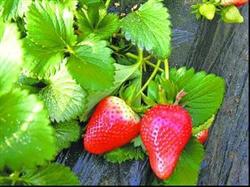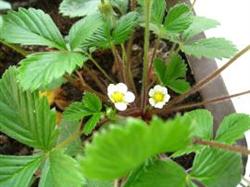Virus-free cultivation techniques of Strawberry

After years of asexual reproduction, strawberry virus disease is becoming more and more serious, the species character of strawberry varieties began to degenerate, and the yield and quality also decreased year by year. The virus-carrying plants are generally characterized by individual dwarfing, smaller leaves, serrated and acute around the leaflets, yellowing of heart leaves, early flowering, small fruit, reduced yield, difficulty in stolon emergence, and decrease in the number of stolons. Virus is a non-cellular form of specific parasite, is the smallest life clothes, contains only one kind of nucleic acid and protein, must be in the cell to proliferate. At present, there are dozens of viruses infecting strawberries, among which strawberry mottle virus, strawberry wrinkle virus, strawberry light yellow edge virus and strawberry vein mosaic virus are four kinds of viruses which are widely distributed and seriously harmful to strawberries. If the yield of plants infected by a single virus is reduced by 20% to 30%, the yield of plants infected by both viruses is reduced by 50%. Strawberry virus is transmitted by stolon seedlings, grafting and aphids. So far, there is no effective medicine to treat strawberry virus disease at home and abroad, and the selection of virus-free seedlings in cultivation is an effective way to reduce the harm of strawberry virus disease. Huh? seedlings that do not contain the above four viruses are called virus-free seedlings. Strawberry virus-free seedlings grew neatly, and the yield and quality were significantly improved. The general stolon number of virus-free seedlings can be increased by 30% to 80%, fruit number by 15% to 40%, single fruit weight by 10% to 15%, and soluble solids content by 5% to 15%. The key points of virus-free cultivation techniques of strawberry are as follows:? 1. Planting: select sandy loam with flat terrain, convenient drainage and irrigation, good ventilation and soft texture, thoroughly remove weeds, control underground pests and disinfect the soil, avoid planting virus-free strawberry seedlings near the old strawberry orchard, and pay special attention to the control of aphids. Continuous cropping of strawberries is not suitable for many times, and flood-drought rotation can reduce the harm of diseases and insect pests. Half a month before planting, the sterilized garden was deeply turned over and applied enough organic fertilizer, and the fully mature farm manure was 3000-4000 kg per mu, 150-200 kg of cake fertilizer and 50 kg of compound fertilizer, which was fully mixed with the soil and leveled. Ridging cultivation, ridge width 50 cm 60 cm, ridge height 20 cm, ridge width 15 cm 20 cm. Two rows were planted on the ridge, and the plant spacing was 20 cm. From mid-September to early October, the seedlings were required to have 5-6 unfolded leaves, roots up to 1-1.3 cm in length, full central buds, no mechanical injury, no quarantine diseases and pests. When planting, the rhizome should be flush with the ground and the top of the stem should be exposed to the ground. In order to facilitate fruit placement and harvest, the inflorescences of the same row of plants are required to face the edge of the ridge. Water thoroughly immediately after planting, and water it 2 or 3 times a week until new leaves are sent out after slow seedling. ? 2. Fertilizer and water management: reasonable fertilization can make strawberry plants grow strong, blossom and bear fruit more, and the fruit is large. In the growing season, it is generally topdressing 3 to 5 times, preferably fully mature human feces and urine. The lack of water in flowering and fruit expansion period will affect the yield, timely irrigation in case of drought, strawberries are not resistant to waterlogging, and excessive soil moisture should be eliminated in time after rain. ? 3. Plant management: timely removal of stolons and excessive buds to reduce nutrient consumption and improve fruit yield and quality. The stolon is the reproductive organ of strawberry, which directly consumes the nutrition of the mother plant, affects the formation and yield of flower buds, and reduces the overwintering ability of the plant, so it should be removed in time. The inflorescence of strawberry is infinite, the first flower bears good fruit, the fruit is large and ripens early, and the later flower often cannot form fruit. Therefore, when the inflorescence is separated, the late blooming buds should be removed properly. The number of fruit per inflorescence of virus-free seedlings increased, and the fruit should be thinned moderately to promote fruit enlargement. When the growth is too prosperous, gray mold and leaf blight are easy to occur. it is necessary to remove the old diseased leaves as soon as possible and control diseases and insect pests in time. When planting in protected land, pay attention to ventilation in the shed. Virus-free strawberry seedlings will also be reinfected in the process of production. in general, if they are still virus-free after 2 years of cultivation, they will be reinfected in the third year. Therefore, it is generally necessary to use new virus-free mother strains to propagate seedlings every 2 to 3 years.
- Prev

Techniques of promoting flowering of strawberries in greenhouse
The purpose of strawberry cultivation is to produce early and appear on the market early, and the key measure is to promote flower bud differentiation and flowering. The measures to promote flower bud differentiation were carried out at the seedling stage, and flowering should be promoted after transplanting. The methods of promoting flowering are as follows: 1. Temperature and humidity management in the greenhouse. The temperature in the shed is 30 degrees during the day and above 10 degrees at night.
- Next

Prevention and control of strawberry snake eye disease
It is not only harmful to leaves, but also to petiole and fruit stalk, which is a common disease of strawberry. 1. Symptoms. A small dark purple spot is formed at the initial stage of the disease, and then expands into a nearly round or oval spot. The edge of the spot is purplish red, the center is grayish white or grayish brown, and there are slight wheel lines, which make the whole spot look like a snake's eye.
Related
- Moge, come on! The staff of the peasant association in the producing area of cantaloupe were frightened when the crowd gathered.
- Causes and Solutions of low Fruit setting rate of Apple
- Symptoms and control measures of passion fruit virus disease
- Fruit growing lesson: how do apple orchards keep high yields?
- Can you build orchards in the mountains? What are the pros and cons?
- How to manage the coloring period of Crisson grape?
- This paper introduces the processing technology of two kinds of fig products.
- How much is a month for retired teachers in rural areas by 2020?
- How can strawberry planting increase sugar content? We should pay attention to management in many aspects.
- What are the cultivation techniques on how to improve the yield of golden fruit?

